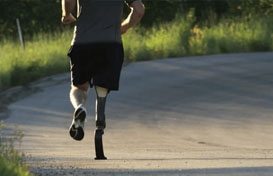When a person loses a limb, he or she may experience phantom pain or phantom sensation that feels as if it is coming from the missing limb. According to experts, almost everyone experiences phantom sensations after losing a limb. About 85 to 95 percent of amputees report phantom pain after losing the limb.
Amputees report a variety of phantom feelings after losing the limb. It may feel as if it is frozen into position. The feeling may be burning, itching, tingling, or even an electric shock sensation. Some amputees even report feeling that the limb is shrinking inward and disappearing. Fortunately, most amputees suffer only phantom sensations and not phantom pain. Some amputees report the feelings as pleasant, because they remind them of the lost limb. Others, however, experience intense discomfort because of phantom pain.
There are a number of ways to treat phantom pain, some of which involve retraining the brain. One such type of therapy is mirror therapy, in which a mirror is placed between the intact limb and the amputated limb. The amputee then spends time each day looking at the limbs in the mirror to rewire the brain. Another type of therapy called peripheral nerve stimulation can be helpful for some amputees. Peripheral nerve stimulation involves an electrical device that is permanently placed along a nerve, which sends rapid-frequency currents to diminish phantom pain.
Although there are a number of techniques to help rid patients of phantom pain, some insurance companies will not cover them. They may label them as “experimental” or “not medically necessary” in order to avoid payment. If you are an amputee and you believe your insurance company is acting in bad faith, call me, Conal Doyle, Amputation Attorney at 310-385-0567. I am also an amputee, and I can help you fight for the coverage you deserve. Call today to learn more or to schedule a free consultation.












